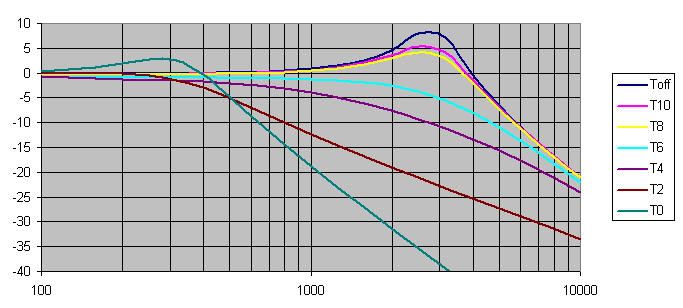Hi, folks. I’m a guitarist, and I have a circuitry problem that evades my electrical understanding.
When a standard tone control is turned all the way down, it created a low-mid frequency bump in addition to the expected high-frequency roll-off. See the teal T0 line here:

Why is that? At 0 the tone pot should just have no resistance in the circuit, so at that point it’s just a fancy junction for a voltage divider. Is it a capacitance thing? If so, how much capacitance is added by a tone pot?
And, more to my point, how can I recreate the effect of a rolled-off tone pot — expected low-pass plus the low-mid frequency bump — with a switch?
I ask because I play most of my lead stuff on the neck with the tone rolled off, kind of a “woman tone” thing. Part of that sound is that low-mid bump. However, most of the rest of my playing is with the tone turned up and some bass rolled off (PTB-style circuit). It’s… a lot of hand-dancing to turn the bass back up and roll the tone off (and switch to the neck sometimes) when it’s solo time. I have an unused switch on my guitar at the moment, and it occurs to me that I could really streamline things for myself if that switch could easily pop me right into that special tone spot I love so dearly.
So, please, help me understand why this is happening! I know an EQ pedal or something could get me there in a much more straightforward fashion, but I’ve got a very particular itch and I’ve resolved to scratch it with a soldering iron.
For reference, I play an H/H with 50s wiring. Master volume, post-volume master tone, and pre-volume master bass cut.
Thanks for any input, folks!
When a standard tone control is turned all the way down, it created a low-mid frequency bump in addition to the expected high-frequency roll-off. See the teal T0 line here:

Why is that? At 0 the tone pot should just have no resistance in the circuit, so at that point it’s just a fancy junction for a voltage divider. Is it a capacitance thing? If so, how much capacitance is added by a tone pot?
And, more to my point, how can I recreate the effect of a rolled-off tone pot — expected low-pass plus the low-mid frequency bump — with a switch?
I ask because I play most of my lead stuff on the neck with the tone rolled off, kind of a “woman tone” thing. Part of that sound is that low-mid bump. However, most of the rest of my playing is with the tone turned up and some bass rolled off (PTB-style circuit). It’s… a lot of hand-dancing to turn the bass back up and roll the tone off (and switch to the neck sometimes) when it’s solo time. I have an unused switch on my guitar at the moment, and it occurs to me that I could really streamline things for myself if that switch could easily pop me right into that special tone spot I love so dearly.
So, please, help me understand why this is happening! I know an EQ pedal or something could get me there in a much more straightforward fashion, but I’ve got a very particular itch and I’ve resolved to scratch it with a soldering iron.
For reference, I play an H/H with 50s wiring. Master volume, post-volume master tone, and pre-volume master bass cut.
Thanks for any input, folks!

Comment